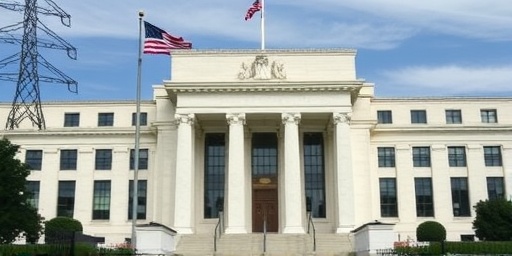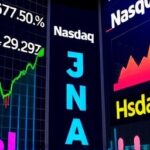Wall Street and international bourses experienced sharp declines on Thursday, erasing recent gains as Federal Reserve officials aired conflicting opinions on the pace and magnitude of upcoming interest rate cuts. The discord, highlighted during a series of speeches and interviews, amplified investor uncertainty and triggered a broad sell-off across equities, bonds, and commodities.
The S&P 500 dropped 1.8% to close at 5,456 points, while the Dow Jones Industrial Average fell 1.2% to 40,112. The Nasdaq Composite, heavily weighted toward tech stocks, suffered the steepest losses, plunging 2.3% to 17,124. Overseas, Europe’s STOXX 600 index slid 1.5%, and Asia’s Nikkei 225 ended down 1.1% following the U.S. session. This synchronized downturn underscores how pivotal the Federal Reserve‘s signals are to global market sentiment.
At the heart of the turmoil were remarks from key Fed policymakers. Chicago Fed President Austan Goolsbee advocated for a measured approach, stating in a CNBC interview, ‘We need to see sustained progress on inflation before committing to deeper rate cuts.’ In contrast, Atlanta Fed President Raphael Bostic suggested a more cautious stance, warning that premature easing could reignite inflationary pressures. These diverging views have cast doubt on the market’s expectation of three to four quarter-point reductions in the federal funds rate by the end of 2024.
Fed Officials’ Mixed Signals Spark Rate Cut Debate
The Federal Reserve‘s internal divisions came into sharp focus this week, as officials grappled with the delicate balance between curbing inflation and supporting economic growth. Chair Jerome Powell, in his latest semiannual testimony before Congress, reiterated that interest rates would remain restrictive until data clearly showed inflation cooling toward the 2% target. However, he stopped short of endorsing the aggressive rate cuts that investors have priced into futures markets.
San Francisco Fed President Mary Daly echoed a dovish tone, noting in a speech to economists, ‘If labor market data softens further, we could see rate cuts as early as the July meeting.’ This optimism clashed with hawkish sentiments from New York Fed President John Williams, who emphasized in a Bloomberg op-ed that ‘rushing into rate cuts risks undoing the hard-won gains against inflation.’ The spread of opinions reflects broader uncertainties in economic indicators: while unemployment ticked up to 4.1% in May, core PCE inflation held steady at 2.6%, complicating the path forward.
Market analysts point to the Federal Open Market Committee’s (FOMC) June minutes, released earlier this week, which revealed that a majority of participants anticipate two rate cuts this year—fewer than the three or more that traders had anticipated. This revelation alone wiped out over $2 trillion in global stock market value, according to data from S&P Global. The keyword here is investor uncertainty: with no clear consensus, traders are hedging bets, leading to heightened volatility as measured by the VIX index, which surged 15% to 18.2.
Historical parallels abound. During the 2019 policy pivot, similar Fed infighting led to a 6% S&P 500 correction before markets stabilized. Experts like Deutsche Bank’s chief strategist, Henry Allen, warn that prolonged disagreement could extend the current bout of investor uncertainty, potentially delaying corporate investment and consumer spending.
Stock Market Sectors Hit Hardest by Rate Cut Delays
The stock market’s reaction was not uniform, with interest rate-sensitive sectors bearing the brunt of the Federal Reserve’s ambiguity. Technology and consumer discretionary stocks, which thrive on low borrowing costs, led the decline. Apple Inc. shares fell 2.7%, while Tesla dropped 3.1%, as investors fretted over higher financing costs impacting gadget sales and electric vehicle demand.
Real estate investment trusts (REITs) and utilities, traditional havens during rate cut expectations, also tumbled. The Vanguard Real Estate ETF (VNQ) lost 2.4%, reflecting fears that sustained high interest rates will continue squeezing property valuations. In contrast, defensive sectors like healthcare and consumer staples showed resilience; Johnson & Johnson rose 0.5%, buoyed by steady dividend yields amid the chaos.
Bond markets echoed the unease, with the 10-year U.S. Treasury yield climbing to 4.45%—its highest in two weeks—as investors demanded higher returns to offset the prospect of fewer rate cuts. This yield spike pressured mortgage rates, which averaged 7.1% for 30-year fixed loans, further dampening housing activity. Goldman Sachs economists estimate that every 0.25% delay in rate cuts could shave 0.1% off GDP growth in the second half of 2024.
Globally, the ripple effects were evident. In Europe, rate cut hopes had fueled a banking rally, but comments from European Central Bank officials aligning with the Fed’s caution sent the sector into reverse; Deutsche Bank shares declined 2.8%. Emerging markets, particularly in Asia, faced capital outflows, with the MSCI Emerging Markets Index down 1.9%. Currency traders noted the U.S. dollar strengthening 0.8% against a basket of majors, exacerbating pressures on export-driven economies like South Korea and Taiwan.
Investor Uncertainty Fuels Broader Economic Concerns
Investor uncertainty has permeated beyond Wall Street, influencing corporate decision-making and household finances. A survey by the National Association for Business Economics revealed that 62% of CFOs are delaying capital expenditures due to unclear Federal Reserve guidance on interest rates. This hesitation could slow the recovery in manufacturing, where the ISM index improved to 48.7 in June but remains below the expansionary 50 threshold.
For everyday Americans, the debate over rate cuts translates to tangible impacts. Credit card rates, already averaging 21.5%, are unlikely to ease soon, straining household budgets amid persistent grocery and energy costs. Retirement savers watching 401(k)s evaporate in the stock market downturn are particularly vulnerable; the average balanced fund lost 1.5% this week, per Morningstar data.
Commodities markets added to the volatility, with oil prices dipping below $80 per barrel as rate cut delays signal weaker global demand. Gold, a traditional safe haven, paradoxically fell 1.2% to $2,310 an ounce, as a stronger dollar overshadowed its appeal. Cryptocurrencies, often correlated with risk assets, saw Bitcoin slide 3.5% to $61,200, highlighting the interconnectedness of traditional and alternative investments in times of Federal Reserve-induced turbulence.
Prominent voices in finance weighed in on the growing investor uncertainty. BlackRock CEO Larry Fink, in a letter to clients, urged the Fed to provide clearer forward guidance, stating, ‘Ambiguity in monetary policy erodes confidence and hampers long-term planning.’ Similarly, JPMorgan Chase’s Jamie Dimon cautioned in an earnings call that ‘divergent Fed views could prolong the soft landing scenario, testing resilience across sectors.’
Looking Ahead: What the Next FOMC Meeting Could Mean for Markets
As markets digest the Federal Reserve’s fractured stance, all eyes turn to the July 30-31 FOMC meeting, where the next interest rate decision will be announced. Futures markets now imply a 65% chance of a rate cut in September, down from 85% a week ago, per CME FedWatch Tool data. If officials maintain their current hawkish tilt, analysts predict further stock market pressure, with the S&P 500 potentially testing 5,300 support levels.
Yet, opportunities may emerge for contrarian investors. Sectors like financials could benefit from higher-for-longer interest rates, as banks enjoy wider net interest margins. Value stocks in energy and industrials, undervalued after the tech-led rally, might attract inflows if rate cut expectations reset lower. International diversification could also gain traction, with markets in Japan and Europe potentially decoupling if their central banks proceed with easing.
Broader implications extend to fiscal policy. With the U.S. presidential election looming, any perception of Fed politicization could intensify investor uncertainty. Economists at the Peterson Institute for International Economics forecast that sustained high interest rates might push the federal budget deficit higher, as debt servicing costs exceed $1 trillion annually by 2025.
In the coming weeks, incoming data on jobs, inflation, and consumer spending will be scrutinized for clues on the rate cut path. A cooler-than-expected CPI report on July 11 could shift the narrative toward dovishness, potentially sparking a market rebound. Conversely, sticky inflation might solidify the Fed’s resolve, prolonging the current bout of volatility. For investors navigating this landscape, diversification and a focus on fundamentals remain key strategies amid the Federal Reserve’s ongoing debate.
The global economy stands at a crossroads, where the Federal Reserve’s ability to forge consensus on interest rates will dictate not just stock market trajectories but the pace of recovery worldwide. As uncertainty lingers, stakeholders from boardrooms to kitchen tables await clearer signals to chart the course ahead.









